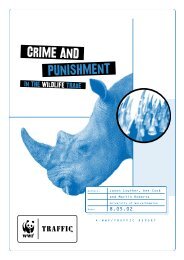Forest renaissance - The role of state forestry in Britain ... - WWF UK
Forest renaissance - The role of state forestry in Britain ... - WWF UK
Forest renaissance - The role of state forestry in Britain ... - WWF UK
Create successful ePaper yourself
Turn your PDF publications into a flip-book with our unique Google optimized e-Paper software.
FOREST RENAISSANCE • THE ROLE OF STATE FORESTRY IN BRITAIN 1919-2050: A DISCUSSION PAPERA New Future for State <strong>Forest</strong>s<strong>in</strong> Brita<strong>in</strong>14“State forests are muchmore ecologicallyrobust.”What do we want?Develop<strong>in</strong>g a futurevision for <strong>state</strong> forestsIn the follow<strong>in</strong>g section, we present avision <strong>of</strong> how forests <strong>in</strong> general, and <strong>state</strong>forests <strong>in</strong> particular, might appear <strong>in</strong>2050.England, Scotland and Wales have larger,higher quality and more varied forest e<strong>state</strong>swhich are supported, shaped and <strong>in</strong>fluencedby many people. <strong>The</strong>re is diversity <strong>in</strong> foresttypes and structures and <strong>in</strong> managementapproaches. In the first two decades <strong>of</strong> the20th century, partnerships between <strong>state</strong>forest bodies, private owners, local authoritiesand others helped to recreate large nativeforests throughout England and Wales, while<strong>in</strong> Scotland and Wales several uneconomic<strong>state</strong>-owned conifer plantations were restoredto native species. Long deforested areas, suchas the famous Sherwood <strong>Forest</strong>, theCaledonian p<strong>in</strong>ewoods and the Atlanticoakwoods <strong>of</strong> Scotland have re-emergedthrough negotiations with local communities.Brita<strong>in</strong> is recognised as an <strong>in</strong>ternational leader<strong>in</strong> forest landscape restoration. More peopleare dependent on forests for part <strong>of</strong> their<strong>in</strong>comes, with leisure activities <strong>of</strong>tenreplac<strong>in</strong>g <strong>forestry</strong> <strong>in</strong> ma<strong>in</strong>ta<strong>in</strong><strong>in</strong>g rurallivelihoods. <strong>Forest</strong> products are an<strong>in</strong>creas<strong>in</strong>gly important part <strong>of</strong> the economy,replac<strong>in</strong>g alternatives which have highersocial and environmental costs.Exist<strong>in</strong>g <strong>state</strong> forests and woodlands arechang<strong>in</strong>g. While some plantations rema<strong>in</strong>,more areas are under cont<strong>in</strong>uous covermanagement and native species and ourhardwood forests are start<strong>in</strong>g to berecognised as among the best <strong>in</strong> the world. Agreater emphasis on high-value products anduses – hardwoods, non-timber forest productsand recreation – has changed both nature <strong>of</strong>management and choice <strong>of</strong> tree. <strong>The</strong> vastmajority <strong>of</strong> Brita<strong>in</strong>’s <strong>state</strong> forests are trulymulti-purpose with managers focus<strong>in</strong>g on thewhole landscape, <strong>in</strong>tegrat<strong>in</strong>g whereverpossible natural ecological processes. Thirdparty certification provides the framework forcont<strong>in</strong>ued improvements and is recognised asa credible global model.State forests are much more ecologicallyrobust. Previously threatened species such asthe honey buzzard and p<strong>in</strong>e marten are secureand spread<strong>in</strong>g back <strong>in</strong>to lowland areas wheretheir existence was previously a distantmemory: several have been removed from the<strong>UK</strong> Red List <strong>of</strong> endangered species. For thefirst time s<strong>in</strong>ce Neolithic humans clearedforests with fl<strong>in</strong>t axes, truly wild forests aregrow<strong>in</strong>g aga<strong>in</strong> <strong>in</strong> places, through naturalregeneration and negotiated restoration.Brita<strong>in</strong> is <strong>in</strong>creas<strong>in</strong>gly seen as an importantdest<strong>in</strong>ation for forest-based adventureholidays.An expand<strong>in</strong>g network <strong>of</strong> protected areas andmanaged natural forests l<strong>in</strong>ks naturalwoodland fragments with areas undergo<strong>in</strong>grestoration. Reserves are develop<strong>in</strong>g oldgrowthcharacteristics.People play a more central <strong>role</strong> <strong>in</strong> decisionsabout their local forests. New technologyhelps consultation and a new generationunderstands the importance and values <strong>of</strong>forests. State forest managers’ expertise andremit has changed; they are expected to listenmore and to liaise with local people, to ensurethat necessary trade-<strong>of</strong>fs between differentforest functions are understood and properlydebated. <strong>Forest</strong>ry is considered one <strong>of</strong> thesafer <strong>in</strong>dustries and there are more womenenter<strong>in</strong>g the pr<strong>of</strong>ession at all levels. Peopleare aware <strong>of</strong> our forest footpr<strong>in</strong>t abroad andBrita<strong>in</strong>, particularly through consumer choice<strong>of</strong> certified products and a green publicprocurement policy, helps improvemanagement <strong>in</strong> export<strong>in</strong>g countries.Despite a grow<strong>in</strong>g resource base, Brita<strong>in</strong> stillrelies on timber imports, and the need for


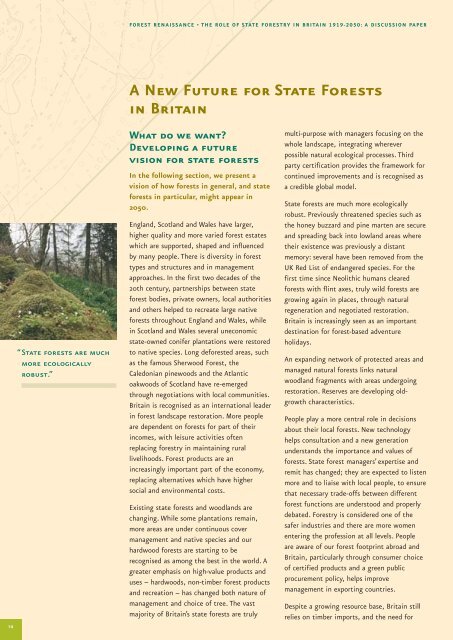
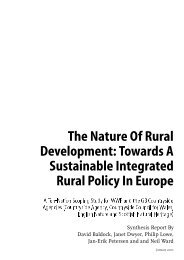
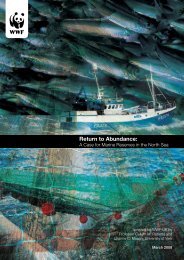

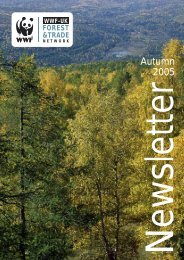

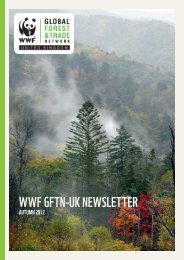

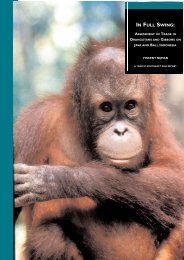
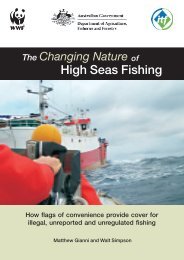
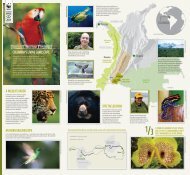
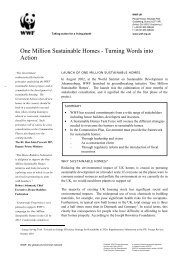
![[PDF] Causes for concern: chemicals and wildlife - WWF UK](https://img.yumpu.com/31929970/1/184x260/pdf-causes-for-concern-chemicals-and-wildlife-wwf-uk.jpg?quality=85)
